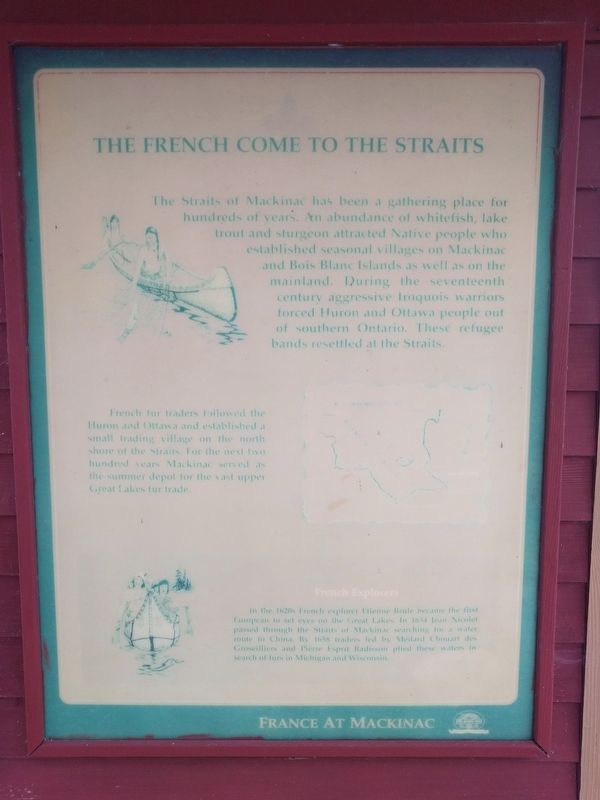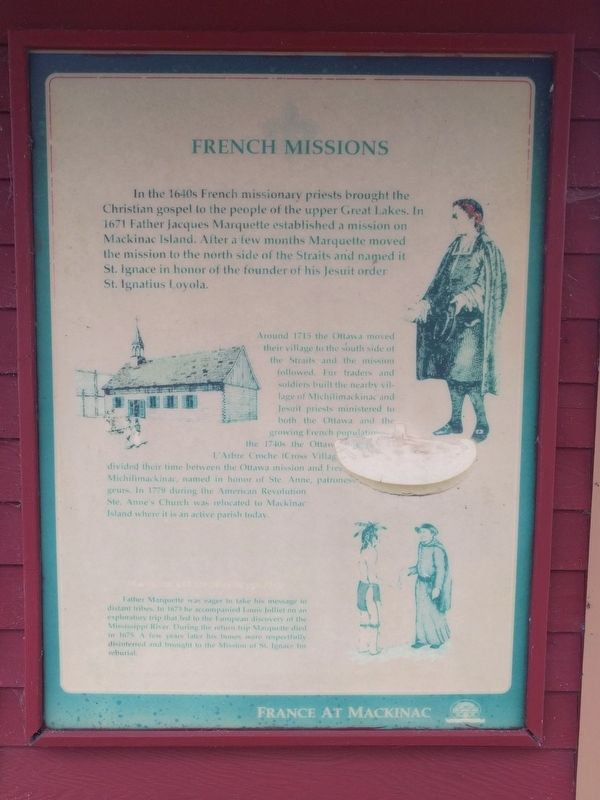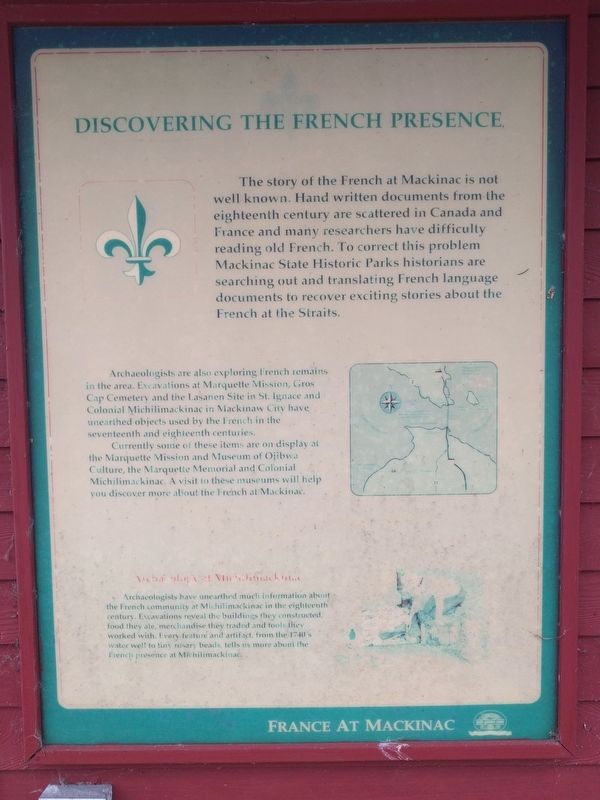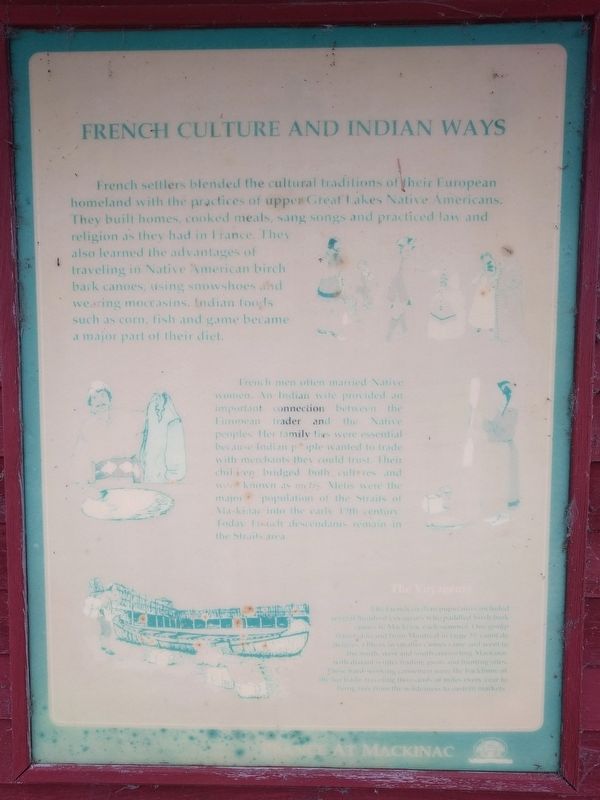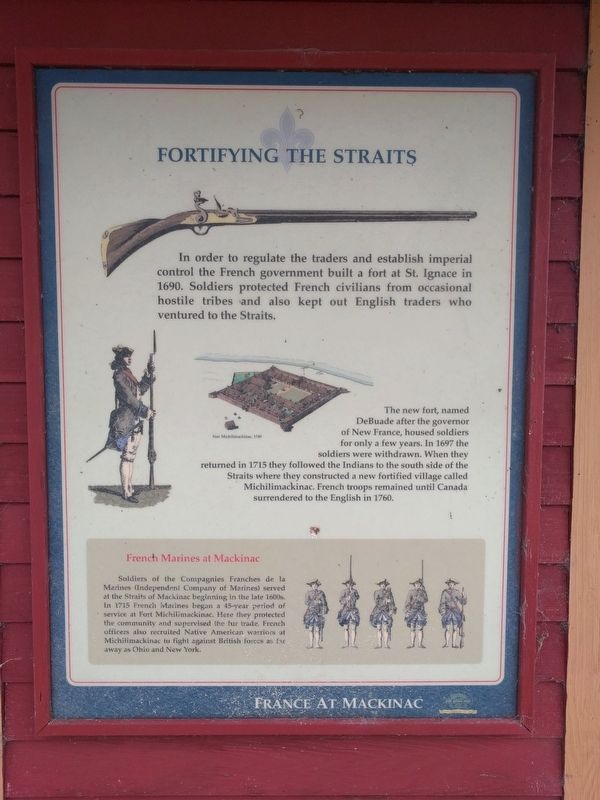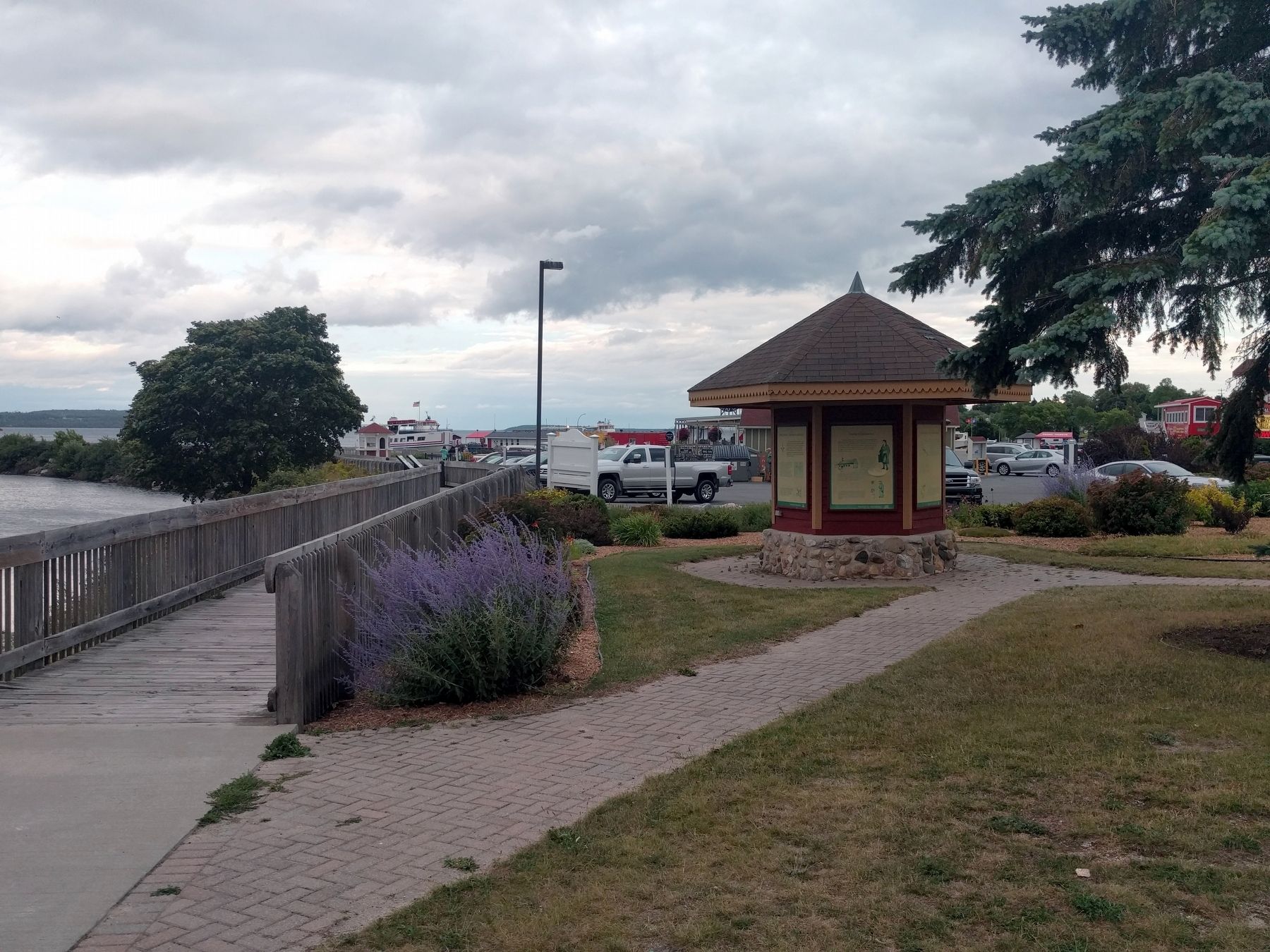St. Ignace in Mackinac County, Michigan — The American Midwest (Great Lakes)
France at Mackinac
The French Come to the Straits
The Straits of Mackinac has been a gathering place for hundreds of years. An abundance of whitefish, lake trout and sturgeon attracted Native people who established seasonal villages on Mackinac and Bois Blanc Islands as well as on the mainland. During the seventeenth century aggresive Iroquois warriors forced Huron and Ottawa people out of southern Ontario. These refugee bands resettled at the Straits.
French fur traders followed the Huron and Ottawa and established a small trading village on the north shore of the Straits. For the next two hundred years Mackinac served as the summer depot for the vast upper Great Lakes fur trade.
French Explorers
In the 1620s French explorer Etienne Brule became the first European to set eyes on the Great Lakes. In 1634 Jean Nicolet passed through the Straits of Mackinac searching for a water route to China. By 1658 traders led by Medard Chouart des Groseilliers and Pierre Esprit Radisson plied these waters in search of furs in Michigan and Wisconsin.
French Missions
In the 1640s French missionary priests brought the Christian gospel to the people of the upper Great Lakes. In 1671 Father Jacques Marquette established a mission on Mackinac Island. After a few months Marquette moved the mission to the north side of the Straits and named it St. Ignace in honor of the founder of his Jesuit order St. Ignatius Loyola.
Around 1715 the Ottawa moved their village to the south side of the Straits and the mission followed. Fur traders and soldiers built the nearby village of Michilimackinac and Jesuit priests ministered to both the Ottawa and the growing French population ____ the 1740s the Ottawa _____ L'Arbre Croche (Cross Village _____ ) divided their time between the Ottawa mission and French _____ Michilimackinac, named in honor of Ste. Anne, patroness _____ voyageurs. In 1779 during the American Revolution Ste. Annes Church was relocated to Mackinac Island where it is an active parish today.
Father Marquette was eager to take his message to distant tribes. In 1673 he accompanied Louis Jolliet on an exploratory trip that led to the European discovery of the Mississippi River. During the return trip Marquette died in 1675. A few years later his bones were respectfully disinterred and brought to the Mission of St. Ignace for reburial.
Discovering the French Presence
The story of the French at Mackinac is not well known. Hand written documents from the eighteenth century are scattered in Canada and France and many researchers have difficulty reading old French. To correct this problem Mackinac State Historic Parks historians are searching out and translating French language documents to recover exciting stories about the French at the Straits.
Archaeologists are also exploring French remains in the area. Excavations at Marquette Mission, Gros Cap Cemetery and the Lasanen Site in St. Ignace and Colonial Michilimackinac in Mackinaw City have unearthed objects used by the French in the seventeenth and eighteenth centuries.
Currently some of these items are on display at the Marquette Mission and Museum of Ojibwa Culture, the Marquette Memorial and Colonial Michilimackinac. A visit to these museums will help you discover more about the French at Mackinac.
Archaeology at Michilimackinac
Archaeologists have unearthed much information about the French community at Michilimackinac in the eighteenth century. Excavations reveal the buildings they constructed, food they ate, merchandise they traded and tools they worked with. Every feature and artifact, from the 1740's water well to tiny rosary beads, tells us more about the French presence at Michilimackinac.
French Culture and Indian Ways
French settlers blended the cultural traditions of their European homeland with the practices of upper Great Lakes Native Americans. They built homes, cooked meals, sang songs and practiced law and religion as they had in France. They also learned the advantages of traveling in Native American birch bark canoes, using snowshoes and wearing moccasins. Indian foods such as corn, fish and game became a major part of their diet.
French men often married Native women. An Indian wife provided an important connection between the European trader and the Native peoples. Her family ties were essential because Indian people wanted to trade with merchants they could trust. Their children bridged both cultures and were known as metis. Metis were the major population of the Straits of Mackinac into the early 19th century. Today French descendants remain in the Straits area.
Fortifying the Straits
In order to regulate the traders and establish imperial control the French government built a fort at St. Ignace in 1690. Soldiers protected French civilians from occasional hostile tribes and also kept out English traders who ventured into the Straits.
The new fort, named DeBuade after the governor of New France, housed soldiers for only a few years. In 1697 the soldiers were withdrawn. When they returned in 1715 they followed the Indians to the south side of the Straits where they constructed a new fortified village called Michilimackinac. French troops remained until Canada surrendered to the English in 1760.
French Marines at Mackinac
Soldiers of the Compagnies Franches de la Marines (Independent Company of Marines) served at the Straits of Mackinac beginning in the late 1600s. In 1715 French Marines began a 45-year period of service at Fort Michilimackinac. Here they protected the community and supervised the fur trade. French officers also recruited Native American warriors at Michilimackinac to fight against British forces as far away as Ohio and New York.
Erected by Mackinac State Historic Parks.
Topics. This historical marker is listed in these topic lists: Exploration • Forts and Castles • Industry & Commerce • Native Americans. A significant historical year for this entry is 1634.
Location. 45° 51.918′ N, 84° 43.171′ W. Marker is in St. Ignace, Michigan, in Mackinac County. Marker is on South State Street (Business Interstate 75) north of McCann Street, on the right when traveling north. Marker is along the Huron Boardwalk, just before it turns toward Wawatam Park and the Wawatam Lighthouse. Touch for map. Marker is at or near this postal address: 251 South State Street, Saint Ignace MI 49781, United States of America. Touch for directions.
Other nearby markers. At least 8 other markers are within walking distance of this marker. Heritage of Fishermen in this Area (within shouting distance of this marker); State Ferries, 1923-1957 (about 300 feet away, measured in a direct line); The Chief Dock Kiosk (about 600 feet away); Antique Railroad Bell (about 600 feet away); The Chief Dock (about 700 feet away); Mooring Facilities (about 700 feet away); William H. Barnum (approx. 0.2 miles away); Great Lakes Shipwrecks and Michigan's Underwater Preserves (approx. 0.2 miles away). Touch for a list and map of all markers in St. Ignace.
Credits. This page was last revised on September 16, 2019. It was originally submitted on September 16, 2019, by Joel Seewald of Madison Heights, Michigan. This page has been viewed 288 times since then and 14 times this year. Photos: 1, 2, 3, 4, 5, 6. submitted on September 16, 2019, by Joel Seewald of Madison Heights, Michigan.
